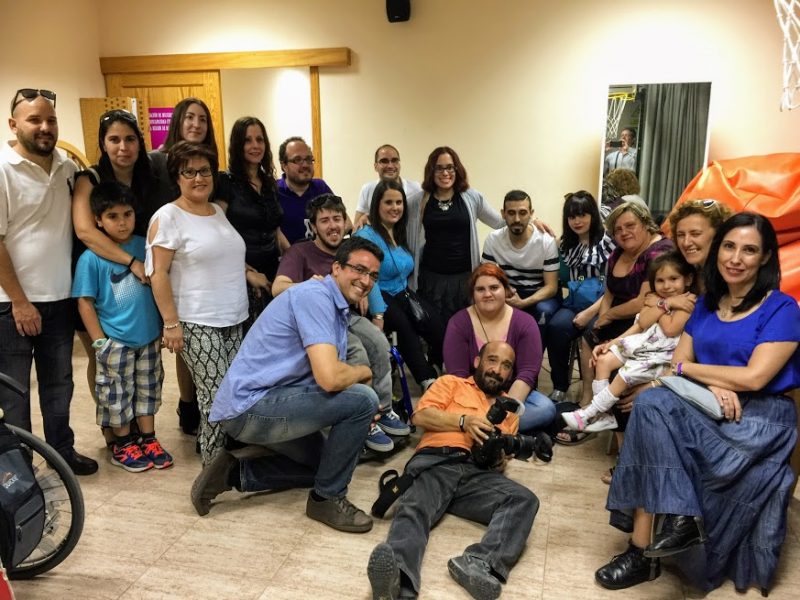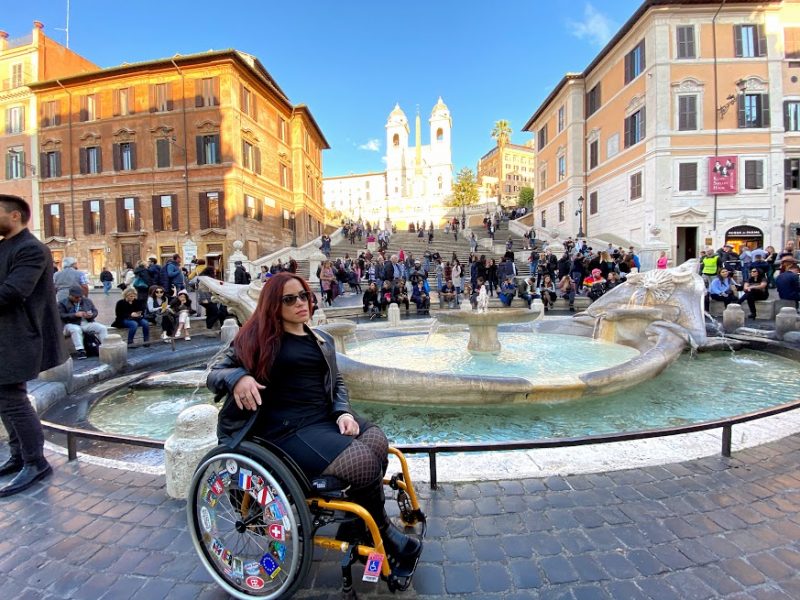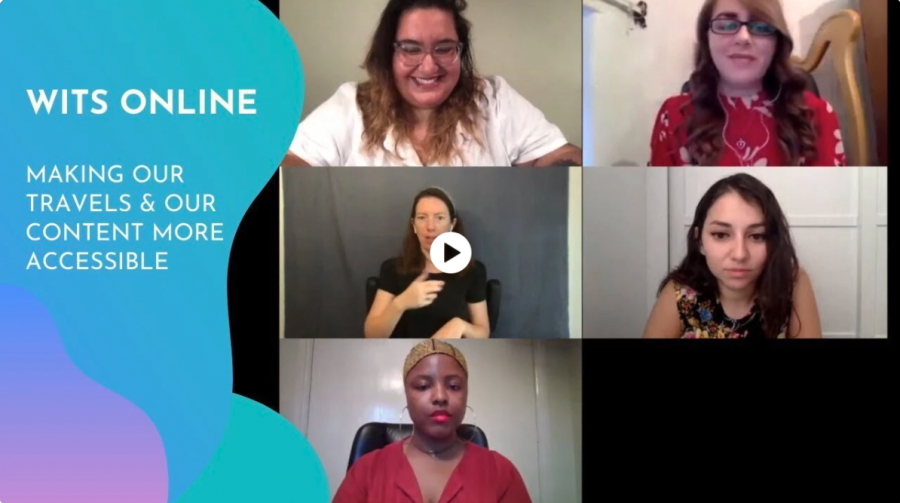“If they don’t give you a seat at the table, bring in a folding chair.”
Shirley Chisholm
Having been born with spina bifida and hydrocephalus, I grew up always feeling like I was in the way — an inconvenience. It didn’t really occur to me at the time that people should accommodate me. I used a wheelchair part-time for long distances, and still do. Time and again, this would lead to my becoming frustrated and discouraged.
Fortunately, my Mom always encouraged me to be my own advocate while she also advocated for me. Both my parents nurtured my activism when I decided, at age 10, to speak up for spina bifida awareness and accessibility.
It all started with demanding locks on the doors of accessible bathroom stalls in elementary school and making sure my classrooms in middle and high school had ramp access. My life transformed as I moved from self-pity and self-loathing to anger and frustration at not being included in everything. Eventually, that transformed into determination to make public places inclusive of everyone.
Fighting for Inclusive Accessibility at College
Starting out at Valencia College, I realized many of the older campus buildings were very inaccessible. I found it difficult to open the door for myself and sometimes I would have to leave my wheelchair outside when I used a bathroom. I tried to imagine what it was like for fellow students who didn’t have the option to walk.
So, to change this, I decided to start from the top. I asked to meet with the college president to interview him for the student newspaper about accessibility. I then offered him a tour of his own campus from the perspective of a wheelchair user — including the bathrooms. Yep, we literally went there!
From then on, I sat in on faculty meetings that were open to the public and would often stay and chat with administration leaders to express my concerns about the inaccessibility on campus.
Finally, more than a year after starting my crusade, a chance meeting with a college vice president led to me being invited to lunch with the facilities department and the architect overseeing renovations to the campuses.
I had already graduated with my associate’s degree from Valencia when I finally received word that all of the changes I fought for had been implemented. Needless to say, it was quite an emotional moment for me. I realized that my actions had made an impact. It really hit home for me that I could make a difference in my environment. I have power.
Growing a Community Focused on Accessibility
During my senior year at the University of Central Florida, I started a blog to raise awareness of spina bifida. I also started reaching out to celebrities and public officials, hoping to get someone interested in becoming a “spokesperson” for the cause.
While my endeavors appeared to yield few results, I began receiving countless comments, emails, and social media messages. I had moms of children with spina bifida, as well as adults living with spina bifida, actually thanking me for sharing my experiences.
Many of them said they had never before “met” someone else living with spina bifida, despite the fact that spina bifida is more common than muscular dystrophy, multiple sclerosis, and cystic fibrosis combined.
I was stunned.

I realized then that what was needed most was a sense of community. In truth, I still remain in touch with many of the adults, parents, and families who have connected with me in the past decade, although many of us have yet to meet in person.
This shared sense of community is one of the reasons I have such a strong passion for travel. The idea that a person on the opposite side of the globe can relate to the same experiences as someone like me has intrigued me for a long time. So I was eager to put this to the test during my own travels with family.
Are you a Travel and Culture Content Creator?
Download the free Anti-Oppression Toolkit
Connecting Travel and Accessibility Activism
When my parents and I took a five-week trip to France in 2015, I connected immediately with the country’s spina bifida association. Near the end of our stay, while visiting Paris, we agreed to meet with several families in their group for an al fresco lunch at a restaurant.
I was blown away by how many people showed up, and they weren’t all local to Paris. They came from Normandy and Dijon and other regions to meet our family. What’s more, we sat together for hours, talking about anything and everything, as if we hadn’t just met.
But what really struck me was the similarities we shared.
All of us had faced issues of discrimination, lack of accessibility, and ostracism in our respective communities.

Because of this experience, I now feel motivated whenever I travel to address accessibility issues wherever I personally encounter them.
Taking a Seat at the Table in Paris
During a subsequent visit to Paris in 2018, I ascended to the top of the Tour Montparnasse (Montparnasse Tower) to enjoy one of the best views of the City of Light. It is 59 stories tall, but, to my dismay, to get to the top, you need to climb the top three floors by stairs. While I was able to do this, I couldn’t help but wonder about my many friends who couldn’t climb those three stories and were missing out on the view.
I decided that I needed to contact the city of Paris. So, I emailed Mayor Anne Hidalgo, asking for a possible meeting during my family’s 2019 trip to Paris, where I celebrated my birthday.
Unfortunately, Mayor Hidalgo had other engagements during that time. But her assistant invited me, along with my parents, to meet with him. We also met with the chair of the committee overseeing accessibility for the upcoming 2024 Olympic and Paralympic Games in Paris. The meeting was hosted at their City Hall, the famed and historic Hôtel de Ville.

I couldn’t believe it. I sent an email, and suddenly I had been invited to have a literal seat at the table.
They listened intently to my input and our suggestions. They also shared their plans to create accessible “bubbles” throughout the city. These will be areas where everything is disability-friendly.
To this day, that meeting has been one of the most empowering experiences I’ve had. The visit ended with a private tour of the gorgeous Hôtel de Ville — the palace-turned-City Hall.
Paying it Forward: What I’ve Learned So Far
My other travels have granted me the opportunity to meet, socialize with, and exchange ideas with people from spina bifida groups in Spain and Belgium. I’ve also been in contact with organizations from all over the world. Once I am able to travel again, I hope to meet more individuals in their respective countries.
Indeed, these experiences have broadened my perspective on accessibility and inclusion on a global level. They have served as enriching lessons and reminders of the power of human connection and embracing our shared humanity.

Here are just a few of the observations I have made so far during my travels, and some tips for fellow travelers with disabilities:
1. “Accessibility” means different things to different people.
Be sure to write or call and ask specific questions about the places you’d like to visit or stay in. Remember, the person you contact will know nothing about your specific needs, so it’ll be your job to ask clear questions in order to get specific details about their accommodations.
Also, bear in mind that each country defines things differently than you may be used to.
For example, in Europe and the UK, their “first floor” is actually the “second floor” in the U.S. It happened to me the first time I went to Nice. I had messaged the host and asked if the building had an elevator. It did, but, when we arrived, we discovered the elevator was on the first floor — which is the second floor for us!
2. Know your transportation options.
If your trip includes traveling by train, find out ahead of time if the stations and the trains themselves are accessible. Unfortunately, many are not. If necessary, contact the station and inquire what kind of assistance is available.
3. Communication is key.
If you’re in a country where the local language is foreign to you, make an effort to learn some of the crucial vocabulary you will need. It might help to download a translation app.
4. Enjoy the perks!
There is actually an upside to traveling with a disability. Many places I have traveled to (London, Paris, Rome, etc.), and the U.S., offer free or discounted admission to famous landmarks, museums, and other sites of cultural interest.
In some cases, a person accompanying you will also get to enter free of charge. At many museums, like the Louvre, people with disabilities do not have to wait in line to enter.
Note: some museums or venues require that you present some sort of documentation of your disability. I didn’t have any, but since I travel with my own personal wheelchair, it was proof enough for them.
5. Take advantage of the resources you have available.
When visiting museums or other popular sites, crowds can often be overwhelming and it can be hard to find your way around. Don’t hesitate to ask an employee for directions. Some might even escort you to where you want to go, and they’re more than happy to do it.
6. You have the power of your voice — leverage it.
If you feel you’ve been discriminated against, denied rightful access, or mistreated in any way during your travels, take a moment to compose yourself, and then research and contact the proper authority or management.
And never underestimate the power of Twitter.
Whether you have 5 followers or 50,000, it doesn’t matter. Companies do not like to be called out publicly. They are usually more willing to address a problem when you bring attention to it — albeit in a respectful manner — as opposed to emailing or filling out a complaint card privately.
And, the most important lesson:
Sometimes, when the opportunity isn’t immediately presented to you, you will need to invite yourself to the table. And if need be, bring your own chair — with or without wheels.




